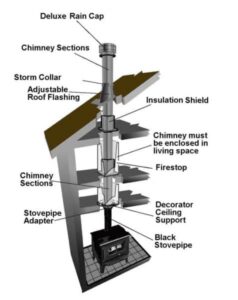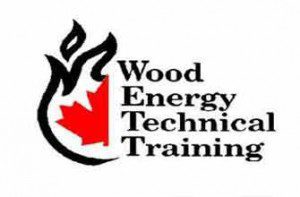All about Chimneys
Understanding how your chimney works can improve your wood burning skills. Proper construction and maintenance is important for your homes safety. Understanding the wood burning process will allow you to enjoy years of heat and enjoyment from your wood fire.
Locating a Chimney Outside Chimney Return to Wood Safety
The chimney is the engine that drives a wood heat system
No wood burning stove, fireplace or furnace can function properly without a good chimney. A good chimney is:
- the correct type for the appliance because there are a lot of options, some unsuitable;
- the correct size for the appliance, which is usually the size of the appliance outlet collar;
- properly located, meaning up through the heated space of the house; and
- properly installed following building code or manufacturer’s instructions exactly.
A good chimney and system design produces desirable performance characteristics:
- Fires are easy to light and draft builds quickly
- Smoke does not fill the room when you try to light a fire
- No smoke spillage when you open the door to tend the fire
- No foul odors or cold air from the hearth when it is not in use
When planning a wood burning system, the first thing you need is reliable advice on matching the appliance to the right type and size of chimney. Most wood heat retailers and chimney sweeps can guide you and there may be government agencies and publications you could get locally. Also, unless you have done it before, we strongly recommend having your chimney professionally installed by someone whose references you have checked. You never want to lie awake at night wondering if an incompetent chimney installation is putting your house and family at risk.
This is good wood stove performance:
(hint: it’s really the chimney that’s doing the performing!)
- When no fire is burning and you open the stove door, air flows into the stove, not out.
- When you light a kindling fire, the smoke immediately flows up the chimney, not into the room.
- A properly built kindling fire burns bright and hot very quickly.
- When you open the stove door to add more wood, smoke does not spill out.
- If you are careful, you can run the stove so that you never smell wood smoke in the house.
Understanding how chimneys work
Think of the chimney as the engine that drives the wood heating system. Think of its fuel as heat. Think of the power it puts out as draft. The more fuel (heat) you give this engine (chimney), the more power (draft) it will deliver. So, the hotter the exhaust gases, the more draft is produced. Draft, by the way, is good. It’s the suction that keeps the smoke from coming into the room. Insulation in the chimney is important because it helps to keep the exhaust hot until it is expelled outside, and so, increases draft.
The chimney works with the stove or fireplace in a kind of feedback loop. Heat in chimney makes draft, which pulls in more combustion air, which makes the fire burn hotter, which delivers more heat to the chimney which makes more draft and so on. An insulated chimney makes more draft with less heat.
In winter, a well-designed and properly installed chimney makes some draft and flows some air upwards, even when no fire is burning. When you build a fire in a stove connected to such a chimney, the kindling ignites easily, draft increases rapidly and you have a nice bright, hot fire right away and no smoking. This is the kind of system you want in your house.
Understanding how houses work
When it is cold outside, the warm air inside the house wants to rise, producing a pressure difference: low pressure low in the house and high pressure high in the house. The pressure difference is called stack effect. The colder it is outside, the greater is the temperature difference, so the stronger is the stack effect. A chimney installed in the middle of a house naturally overcomes stack effect by being as warm, but taller than the house.
Houses are being built more tightly sealed for increased comfort and lower energy costs. This is done by using doors and windows with gaskets and walls with a continuous air barrier (usually plastic film). If you turned on a powerful range hood or downdraft kitchen exhaust in a relatively small, tightly sealed house, it might suck so much air out of the house that the pressure inside would fall enough to overcome chimney draft and suck the smoke out of the stove. It’s not that common yet, but it can happen.
Typical problems and ways to avoid them
- Cold hearths and odors: when no fire is burning, cold air and/or odors seep from the stove.
- The air in a chimney that runs up the outside of the house gets chilled, so the draft in the chimney is less than the stack effect of the house, and the chimney back drafts, making the hearth cold and causing unpleasant odors
- Install the chimney inside the building, keep it as warm and as tall as the building and it will make draft, even when no fire burns
- Open door smoke spillage: when you go to reload, smoke rolls out the door.
- When you open the stove door, a lot of dilution air must flow through the opening to keep the smoke inside; if the exhaust flow is restricted, smoke will roll out into the room
- Go straight up, if possible; avoid 90 degree turns in the flue pipe and offsets in the chimney
- Sluggish performance: smokey fire, hard to get a hot fire burning.
- Large, cold chimneys, like old brick ones, suck up the heat from the exhaust, causing slow draft build up.
- Size the flue to match the stove and use an insulated chimney to keep exhaust hot and moving quickly; never use and air-cooled chimney
Summary of design guidelines
- Put the chimney inside the warm building environment
- Go straight up, no elbows or offsets
- Insulation around the flue liner
- Flue sized to match stove
A word about climate and altitude
If you live in an area that has a real winter “ the ground freezes and you get some snow “ or if you live at high altitude “ say more than 4,000 feet “ you’ll need to follow these design guidelines exactly in order to get perfect performance. You people at low altitude with mild winters may not need to be quite so fussy, but, then again, good design always pays off in better performance.
Call Roger today to book your WETT Certified Inspection of Wood Stove, Fireplace, Outside Boiler or Pellet Stove. We service Angus, Alliston, Barrie, Thornton, Tottenham, Beeton, Orillia, Midland, Penetang, Wasaga Beach and Elmvale.
